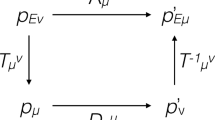Abstract
During a transverse acceleration of a light clock from rest, the mirrors must be tilted so as to retain the light pulse. The mirrors therefore have a normal velocity which increases the frequency of the pulse at each reflection. If a mirror is annihilated, the frequency of the escaping pulse, as a result of many reflections, is that of the relativistic Doppler effect. This holds for any acceleration, if the Fitzgerald contraction is assumed, thereby furnishing a new mechanism for such frequencies. The traditional mechanism, in which the source (subject to the time dilation) generates a pulse modulated by the source motion, is therefore not a unique explanation of the Doppler effect. The new mechanism permits the speculation that radiation preexists in atomic sources, rather than being generated at the instant of release.
Similar content being viewed by others
Reference
S. J. Prokhovnik,Found. Phys. 10, 197 (1980).
Author information
Authors and Affiliations
Rights and permissions
About this article
Cite this article
Kelly, E.M. Relativistic Doppler effect in light clocks construed as a result of prior acceleration. Found Phys 14, 705–720 (1984). https://doi.org/10.1007/BF00736617
Received:
Issue Date:
DOI: https://doi.org/10.1007/BF00736617




